Strategic Human Resource Management
VerifiedAdded on 2022/11/28
|16
|4638
|248
AI Summary
This document discusses strategic human resource management, focusing on the current trends and developments that influence an organization's HR strategy. It also explores the influence of internal and external factors on HR practices and strategy, theories and concepts related to the growth and development of strategic HRM within a chosen organization, and change management models that promote HR strategy. The case of British Airways is used as an example throughout the document.
Contribute Materials
Your contribution can guide someone’s learning journey. Share your
documents today.
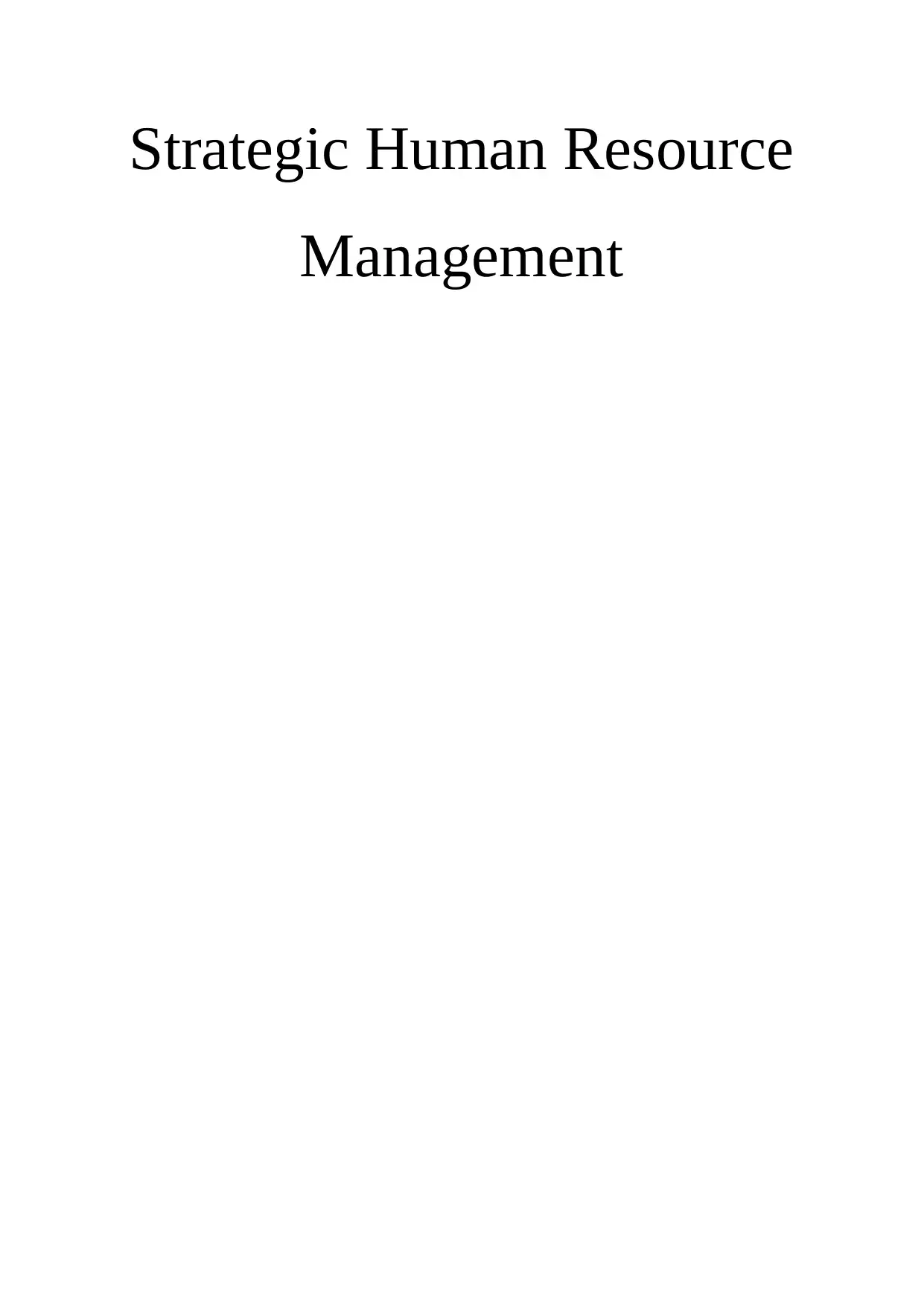
Strategic Human Resource
Management
Management
Secure Best Marks with AI Grader
Need help grading? Try our AI Grader for instant feedback on your assignments.
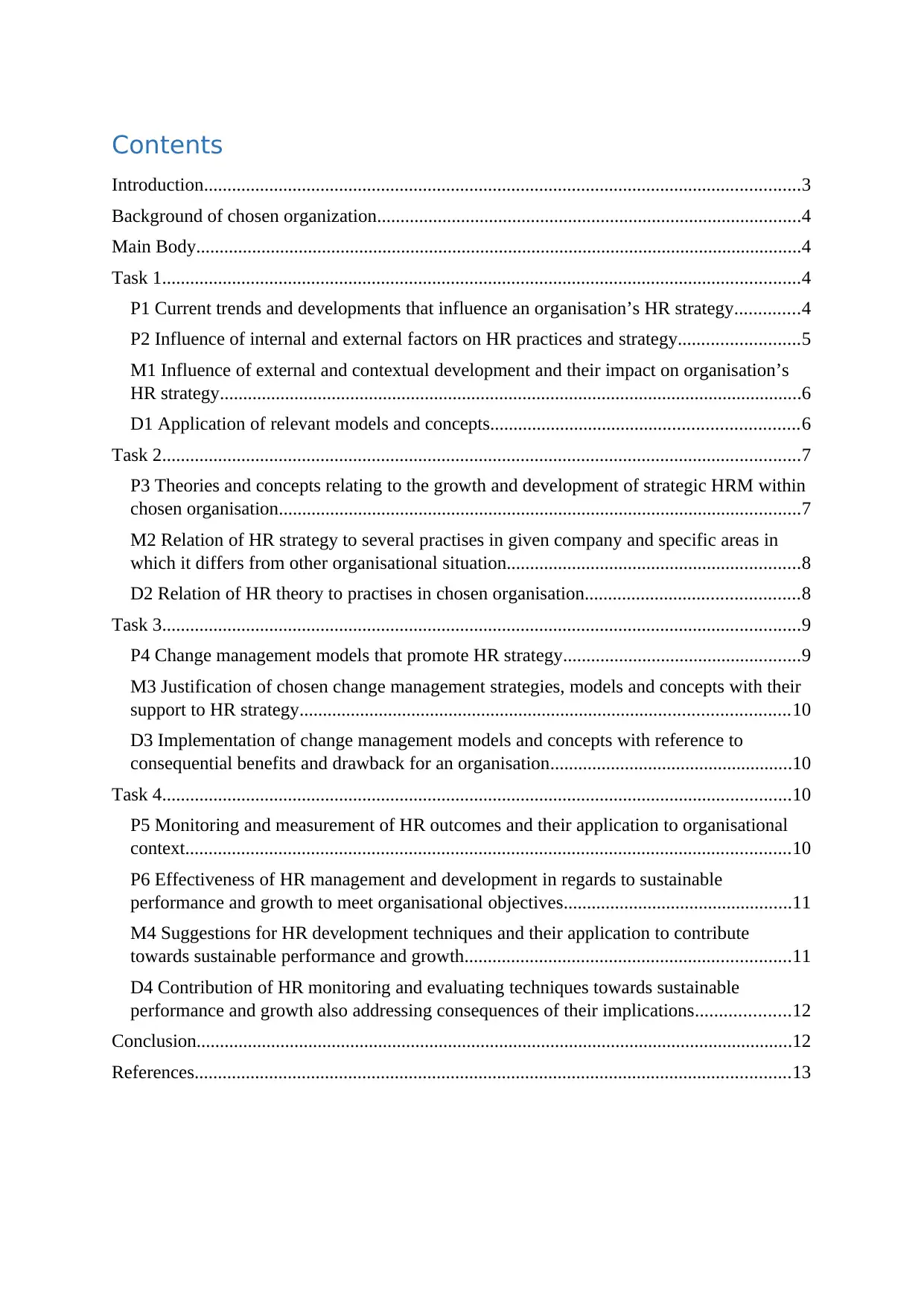
Contents
Introduction................................................................................................................................3
Background of chosen organization...........................................................................................4
Main Body..................................................................................................................................4
Task 1.........................................................................................................................................4
P1 Current trends and developments that influence an organisation’s HR strategy..............4
P2 Influence of internal and external factors on HR practices and strategy..........................5
M1 Influence of external and contextual development and their impact on organisation’s
HR strategy.............................................................................................................................6
D1 Application of relevant models and concepts..................................................................6
Task 2.........................................................................................................................................7
P3 Theories and concepts relating to the growth and development of strategic HRM within
chosen organisation................................................................................................................7
M2 Relation of HR strategy to several practises in given company and specific areas in
which it differs from other organisational situation...............................................................8
D2 Relation of HR theory to practises in chosen organisation..............................................8
Task 3.........................................................................................................................................9
P4 Change management models that promote HR strategy...................................................9
M3 Justification of chosen change management strategies, models and concepts with their
support to HR strategy.........................................................................................................10
D3 Implementation of change management models and concepts with reference to
consequential benefits and drawback for an organisation....................................................10
Task 4.......................................................................................................................................10
P5 Monitoring and measurement of HR outcomes and their application to organisational
context..................................................................................................................................10
P6 Effectiveness of HR management and development in regards to sustainable
performance and growth to meet organisational objectives.................................................11
M4 Suggestions for HR development techniques and their application to contribute
towards sustainable performance and growth......................................................................11
D4 Contribution of HR monitoring and evaluating techniques towards sustainable
performance and growth also addressing consequences of their implications....................12
Conclusion................................................................................................................................12
References................................................................................................................................13
Introduction................................................................................................................................3
Background of chosen organization...........................................................................................4
Main Body..................................................................................................................................4
Task 1.........................................................................................................................................4
P1 Current trends and developments that influence an organisation’s HR strategy..............4
P2 Influence of internal and external factors on HR practices and strategy..........................5
M1 Influence of external and contextual development and their impact on organisation’s
HR strategy.............................................................................................................................6
D1 Application of relevant models and concepts..................................................................6
Task 2.........................................................................................................................................7
P3 Theories and concepts relating to the growth and development of strategic HRM within
chosen organisation................................................................................................................7
M2 Relation of HR strategy to several practises in given company and specific areas in
which it differs from other organisational situation...............................................................8
D2 Relation of HR theory to practises in chosen organisation..............................................8
Task 3.........................................................................................................................................9
P4 Change management models that promote HR strategy...................................................9
M3 Justification of chosen change management strategies, models and concepts with their
support to HR strategy.........................................................................................................10
D3 Implementation of change management models and concepts with reference to
consequential benefits and drawback for an organisation....................................................10
Task 4.......................................................................................................................................10
P5 Monitoring and measurement of HR outcomes and their application to organisational
context..................................................................................................................................10
P6 Effectiveness of HR management and development in regards to sustainable
performance and growth to meet organisational objectives.................................................11
M4 Suggestions for HR development techniques and their application to contribute
towards sustainable performance and growth......................................................................11
D4 Contribution of HR monitoring and evaluating techniques towards sustainable
performance and growth also addressing consequences of their implications....................12
Conclusion................................................................................................................................12
References................................................................................................................................13

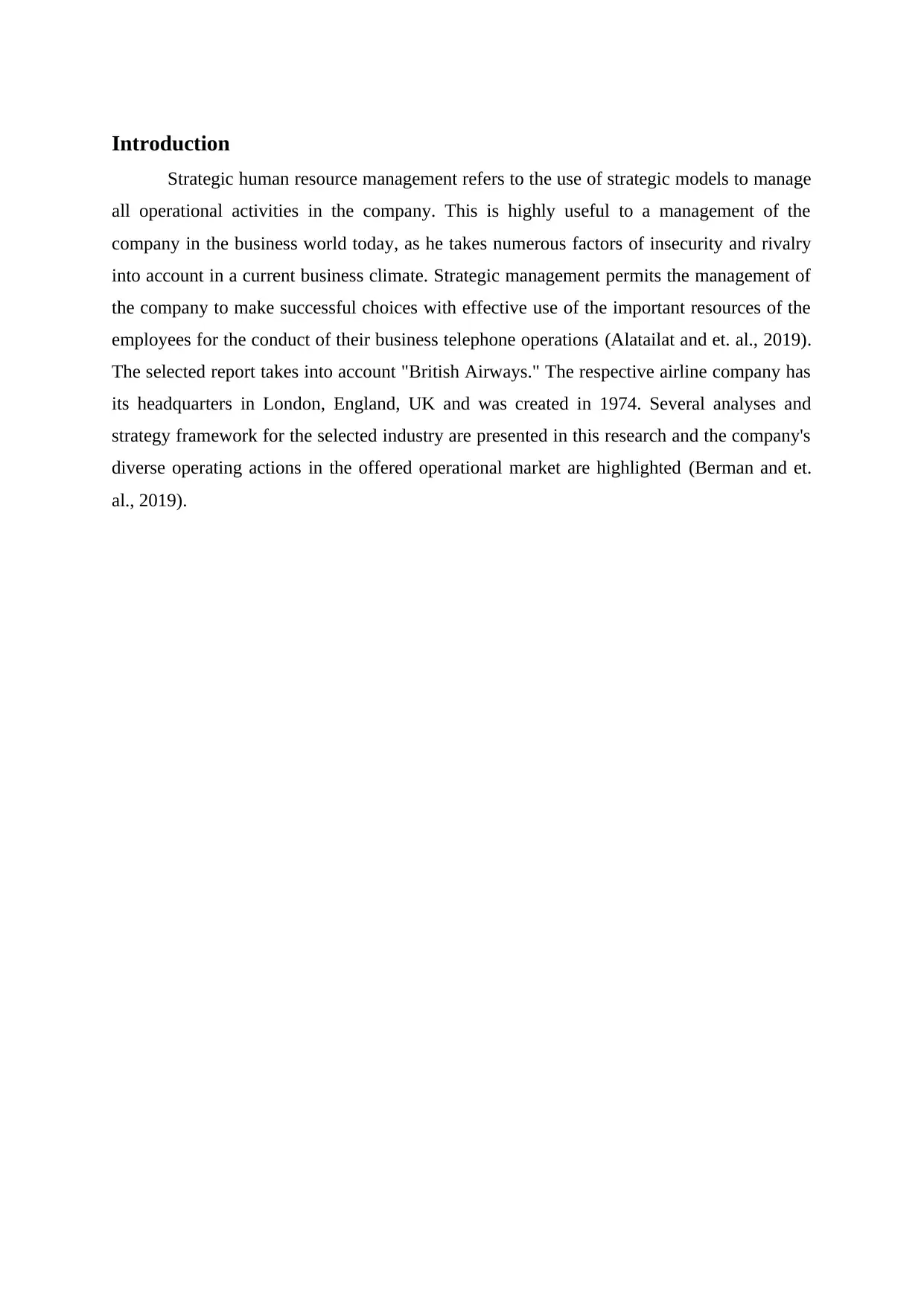
Introduction
Strategic human resource management refers to the use of strategic models to manage
all operational activities in the company. This is highly useful to a management of the
company in the business world today, as he takes numerous factors of insecurity and rivalry
into account in a current business climate. Strategic management permits the management of
the company to make successful choices with effective use of the important resources of the
employees for the conduct of their business telephone operations (Alatailat and et. al., 2019).
The selected report takes into account "British Airways." The respective airline company has
its headquarters in London, England, UK and was created in 1974. Several analyses and
strategy framework for the selected industry are presented in this research and the company's
diverse operating actions in the offered operational market are highlighted (Berman and et.
al., 2019).
Strategic human resource management refers to the use of strategic models to manage
all operational activities in the company. This is highly useful to a management of the
company in the business world today, as he takes numerous factors of insecurity and rivalry
into account in a current business climate. Strategic management permits the management of
the company to make successful choices with effective use of the important resources of the
employees for the conduct of their business telephone operations (Alatailat and et. al., 2019).
The selected report takes into account "British Airways." The respective airline company has
its headquarters in London, England, UK and was created in 1974. Several analyses and
strategy framework for the selected industry are presented in this research and the company's
diverse operating actions in the offered operational market are highlighted (Berman and et.
al., 2019).
Secure Best Marks with AI Grader
Need help grading? Try our AI Grader for instant feedback on your assignments.
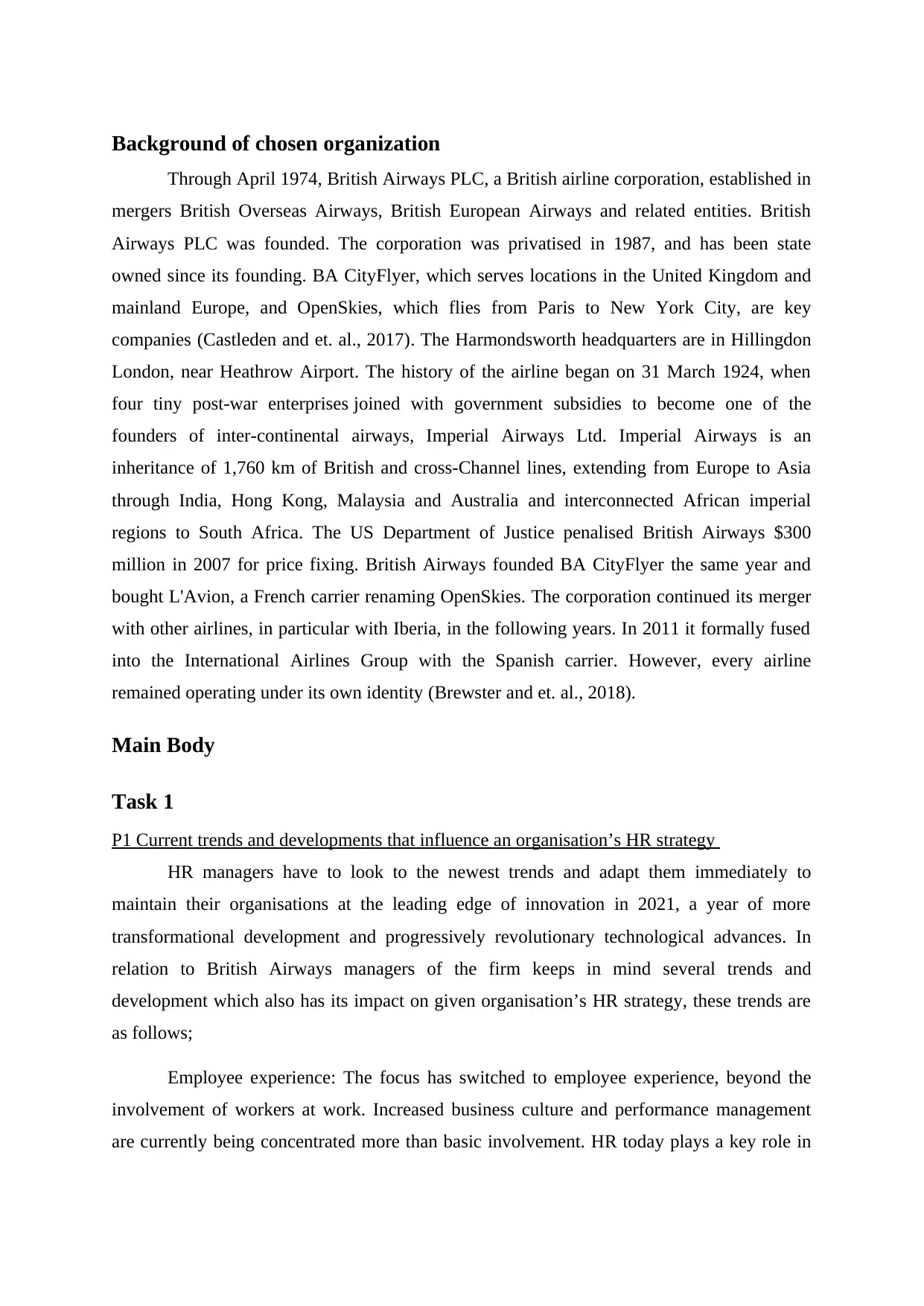
Background of chosen organization
Through April 1974, British Airways PLC, a British airline corporation, established in
mergers British Overseas Airways, British European Airways and related entities. British
Airways PLC was founded. The corporation was privatised in 1987, and has been state
owned since its founding. BA CityFlyer, which serves locations in the United Kingdom and
mainland Europe, and OpenSkies, which flies from Paris to New York City, are key
companies (Castleden and et. al., 2017). The Harmondsworth headquarters are in Hillingdon
London, near Heathrow Airport. The history of the airline began on 31 March 1924, when
four tiny post-war enterprises joined with government subsidies to become one of the
founders of inter-continental airways, Imperial Airways Ltd. Imperial Airways is an
inheritance of 1,760 km of British and cross-Channel lines, extending from Europe to Asia
through India, Hong Kong, Malaysia and Australia and interconnected African imperial
regions to South Africa. The US Department of Justice penalised British Airways $300
million in 2007 for price fixing. British Airways founded BA CityFlyer the same year and
bought L'Avion, a French carrier renaming OpenSkies. The corporation continued its merger
with other airlines, in particular with Iberia, in the following years. In 2011 it formally fused
into the International Airlines Group with the Spanish carrier. However, every airline
remained operating under its own identity (Brewster and et. al., 2018).
Main Body
Task 1
P1 Current trends and developments that influence an organisation’s HR strategy
HR managers have to look to the newest trends and adapt them immediately to
maintain their organisations at the leading edge of innovation in 2021, a year of more
transformational development and progressively revolutionary technological advances. In
relation to British Airways managers of the firm keeps in mind several trends and
development which also has its impact on given organisation’s HR strategy, these trends are
as follows;
Employee experience: The focus has switched to employee experience, beyond the
involvement of workers at work. Increased business culture and performance management
are currently being concentrated more than basic involvement. HR today plays a key role in
Through April 1974, British Airways PLC, a British airline corporation, established in
mergers British Overseas Airways, British European Airways and related entities. British
Airways PLC was founded. The corporation was privatised in 1987, and has been state
owned since its founding. BA CityFlyer, which serves locations in the United Kingdom and
mainland Europe, and OpenSkies, which flies from Paris to New York City, are key
companies (Castleden and et. al., 2017). The Harmondsworth headquarters are in Hillingdon
London, near Heathrow Airport. The history of the airline began on 31 March 1924, when
four tiny post-war enterprises joined with government subsidies to become one of the
founders of inter-continental airways, Imperial Airways Ltd. Imperial Airways is an
inheritance of 1,760 km of British and cross-Channel lines, extending from Europe to Asia
through India, Hong Kong, Malaysia and Australia and interconnected African imperial
regions to South Africa. The US Department of Justice penalised British Airways $300
million in 2007 for price fixing. British Airways founded BA CityFlyer the same year and
bought L'Avion, a French carrier renaming OpenSkies. The corporation continued its merger
with other airlines, in particular with Iberia, in the following years. In 2011 it formally fused
into the International Airlines Group with the Spanish carrier. However, every airline
remained operating under its own identity (Brewster and et. al., 2018).
Main Body
Task 1
P1 Current trends and developments that influence an organisation’s HR strategy
HR managers have to look to the newest trends and adapt them immediately to
maintain their organisations at the leading edge of innovation in 2021, a year of more
transformational development and progressively revolutionary technological advances. In
relation to British Airways managers of the firm keeps in mind several trends and
development which also has its impact on given organisation’s HR strategy, these trends are
as follows;
Employee experience: The focus has switched to employee experience, beyond the
involvement of workers at work. Increased business culture and performance management
are currently being concentrated more than basic involvement. HR today plays a key role in
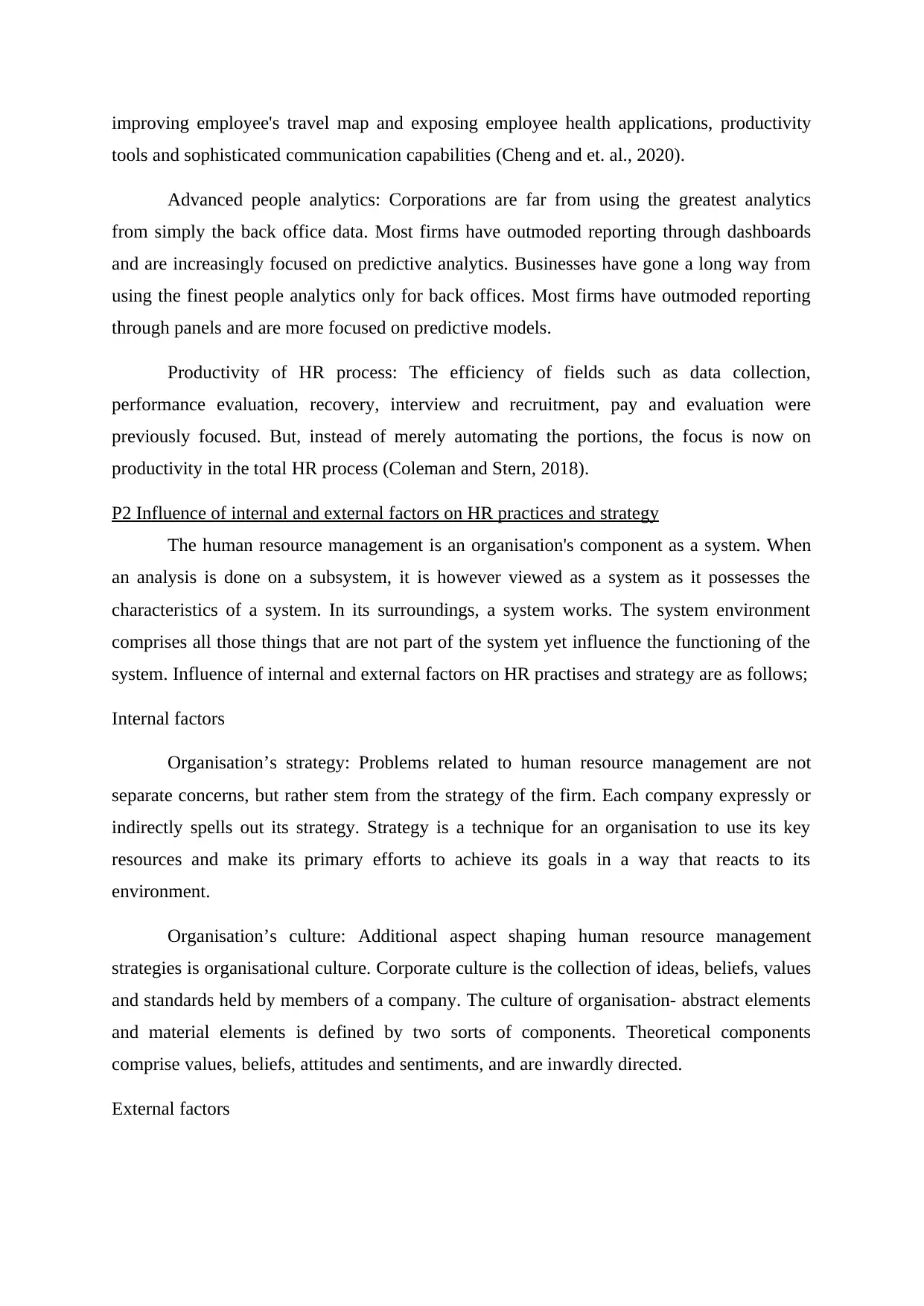
improving employee's travel map and exposing employee health applications, productivity
tools and sophisticated communication capabilities (Cheng and et. al., 2020).
Advanced people analytics: Corporations are far from using the greatest analytics
from simply the back office data. Most firms have outmoded reporting through dashboards
and are increasingly focused on predictive analytics. Businesses have gone a long way from
using the finest people analytics only for back offices. Most firms have outmoded reporting
through panels and are more focused on predictive models.
Productivity of HR process: The efficiency of fields such as data collection,
performance evaluation, recovery, interview and recruitment, pay and evaluation were
previously focused. But, instead of merely automating the portions, the focus is now on
productivity in the total HR process (Coleman and Stern, 2018).
P2 Influence of internal and external factors on HR practices and strategy
The human resource management is an organisation's component as a system. When
an analysis is done on a subsystem, it is however viewed as a system as it possesses the
characteristics of a system. In its surroundings, a system works. The system environment
comprises all those things that are not part of the system yet influence the functioning of the
system. Influence of internal and external factors on HR practises and strategy are as follows;
Internal factors
Organisation’s strategy: Problems related to human resource management are not
separate concerns, but rather stem from the strategy of the firm. Each company expressly or
indirectly spells out its strategy. Strategy is a technique for an organisation to use its key
resources and make its primary efforts to achieve its goals in a way that reacts to its
environment.
Organisation’s culture: Additional aspect shaping human resource management
strategies is organisational culture. Corporate culture is the collection of ideas, beliefs, values
and standards held by members of a company. The culture of organisation- abstract elements
and material elements is defined by two sorts of components. Theoretical components
comprise values, beliefs, attitudes and sentiments, and are inwardly directed.
External factors
tools and sophisticated communication capabilities (Cheng and et. al., 2020).
Advanced people analytics: Corporations are far from using the greatest analytics
from simply the back office data. Most firms have outmoded reporting through dashboards
and are increasingly focused on predictive analytics. Businesses have gone a long way from
using the finest people analytics only for back offices. Most firms have outmoded reporting
through panels and are more focused on predictive models.
Productivity of HR process: The efficiency of fields such as data collection,
performance evaluation, recovery, interview and recruitment, pay and evaluation were
previously focused. But, instead of merely automating the portions, the focus is now on
productivity in the total HR process (Coleman and Stern, 2018).
P2 Influence of internal and external factors on HR practices and strategy
The human resource management is an organisation's component as a system. When
an analysis is done on a subsystem, it is however viewed as a system as it possesses the
characteristics of a system. In its surroundings, a system works. The system environment
comprises all those things that are not part of the system yet influence the functioning of the
system. Influence of internal and external factors on HR practises and strategy are as follows;
Internal factors
Organisation’s strategy: Problems related to human resource management are not
separate concerns, but rather stem from the strategy of the firm. Each company expressly or
indirectly spells out its strategy. Strategy is a technique for an organisation to use its key
resources and make its primary efforts to achieve its goals in a way that reacts to its
environment.
Organisation’s culture: Additional aspect shaping human resource management
strategies is organisational culture. Corporate culture is the collection of ideas, beliefs, values
and standards held by members of a company. The culture of organisation- abstract elements
and material elements is defined by two sorts of components. Theoretical components
comprise values, beliefs, attitudes and sentiments, and are inwardly directed.
External factors
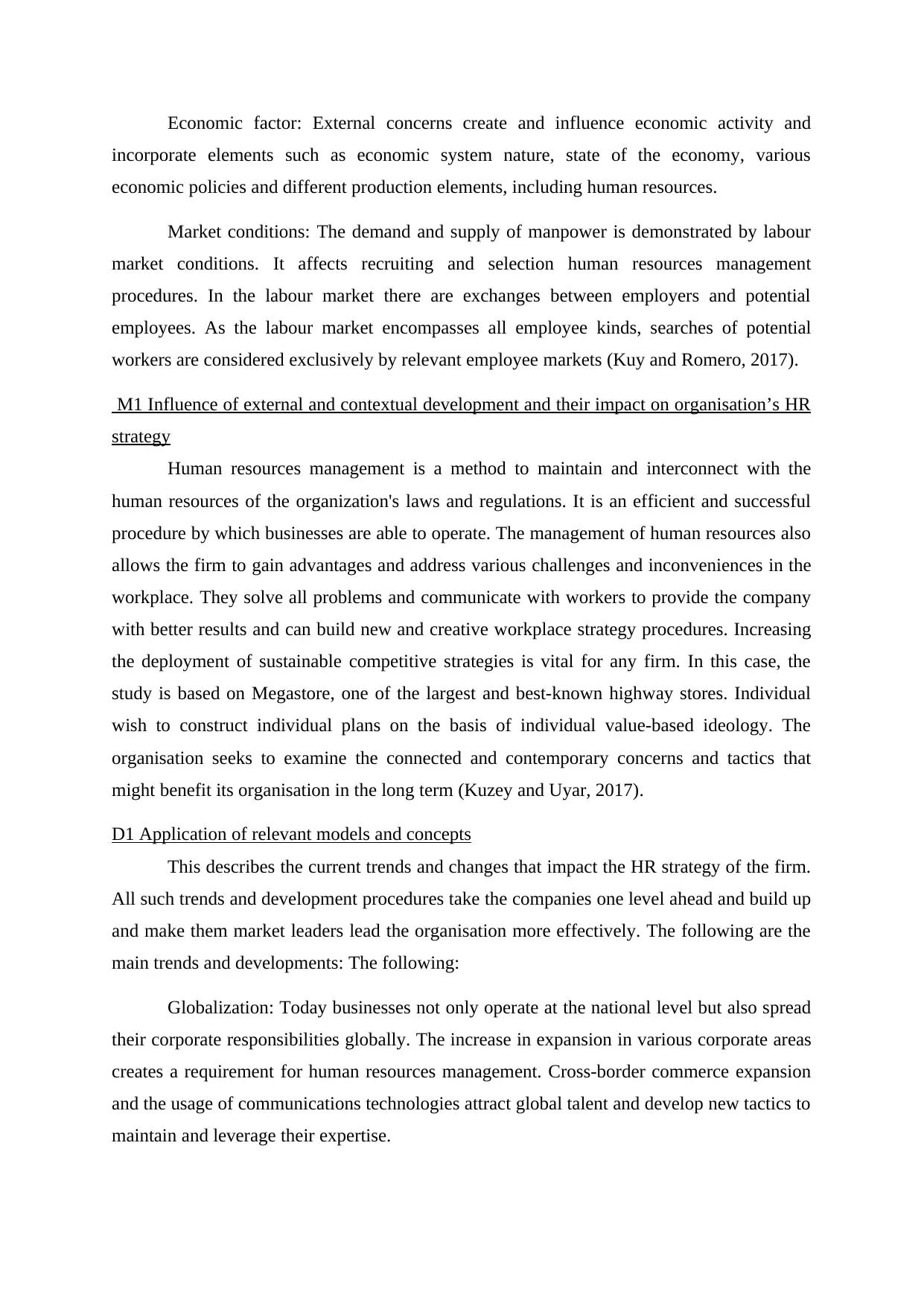
Economic factor: External concerns create and influence economic activity and
incorporate elements such as economic system nature, state of the economy, various
economic policies and different production elements, including human resources.
Market conditions: The demand and supply of manpower is demonstrated by labour
market conditions. It affects recruiting and selection human resources management
procedures. In the labour market there are exchanges between employers and potential
employees. As the labour market encompasses all employee kinds, searches of potential
workers are considered exclusively by relevant employee markets (Kuy and Romero, 2017).
M1 Influence of external and contextual development and their impact on organisation’s HR
strategy
Human resources management is a method to maintain and interconnect with the
human resources of the organization's laws and regulations. It is an efficient and successful
procedure by which businesses are able to operate. The management of human resources also
allows the firm to gain advantages and address various challenges and inconveniences in the
workplace. They solve all problems and communicate with workers to provide the company
with better results and can build new and creative workplace strategy procedures. Increasing
the deployment of sustainable competitive strategies is vital for any firm. In this case, the
study is based on Megastore, one of the largest and best-known highway stores. Individual
wish to construct individual plans on the basis of individual value-based ideology. The
organisation seeks to examine the connected and contemporary concerns and tactics that
might benefit its organisation in the long term (Kuzey and Uyar, 2017).
D1 Application of relevant models and concepts
This describes the current trends and changes that impact the HR strategy of the firm.
All such trends and development procedures take the companies one level ahead and build up
and make them market leaders lead the organisation more effectively. The following are the
main trends and developments: The following:
Globalization: Today businesses not only operate at the national level but also spread
their corporate responsibilities globally. The increase in expansion in various corporate areas
creates a requirement for human resources management. Cross-border commerce expansion
and the usage of communications technologies attract global talent and develop new tactics to
maintain and leverage their expertise.
incorporate elements such as economic system nature, state of the economy, various
economic policies and different production elements, including human resources.
Market conditions: The demand and supply of manpower is demonstrated by labour
market conditions. It affects recruiting and selection human resources management
procedures. In the labour market there are exchanges between employers and potential
employees. As the labour market encompasses all employee kinds, searches of potential
workers are considered exclusively by relevant employee markets (Kuy and Romero, 2017).
M1 Influence of external and contextual development and their impact on organisation’s HR
strategy
Human resources management is a method to maintain and interconnect with the
human resources of the organization's laws and regulations. It is an efficient and successful
procedure by which businesses are able to operate. The management of human resources also
allows the firm to gain advantages and address various challenges and inconveniences in the
workplace. They solve all problems and communicate with workers to provide the company
with better results and can build new and creative workplace strategy procedures. Increasing
the deployment of sustainable competitive strategies is vital for any firm. In this case, the
study is based on Megastore, one of the largest and best-known highway stores. Individual
wish to construct individual plans on the basis of individual value-based ideology. The
organisation seeks to examine the connected and contemporary concerns and tactics that
might benefit its organisation in the long term (Kuzey and Uyar, 2017).
D1 Application of relevant models and concepts
This describes the current trends and changes that impact the HR strategy of the firm.
All such trends and development procedures take the companies one level ahead and build up
and make them market leaders lead the organisation more effectively. The following are the
main trends and developments: The following:
Globalization: Today businesses not only operate at the national level but also spread
their corporate responsibilities globally. The increase in expansion in various corporate areas
creates a requirement for human resources management. Cross-border commerce expansion
and the usage of communications technologies attract global talent and develop new tactics to
maintain and leverage their expertise.
Paraphrase This Document
Need a fresh take? Get an instant paraphrase of this document with our AI Paraphraser
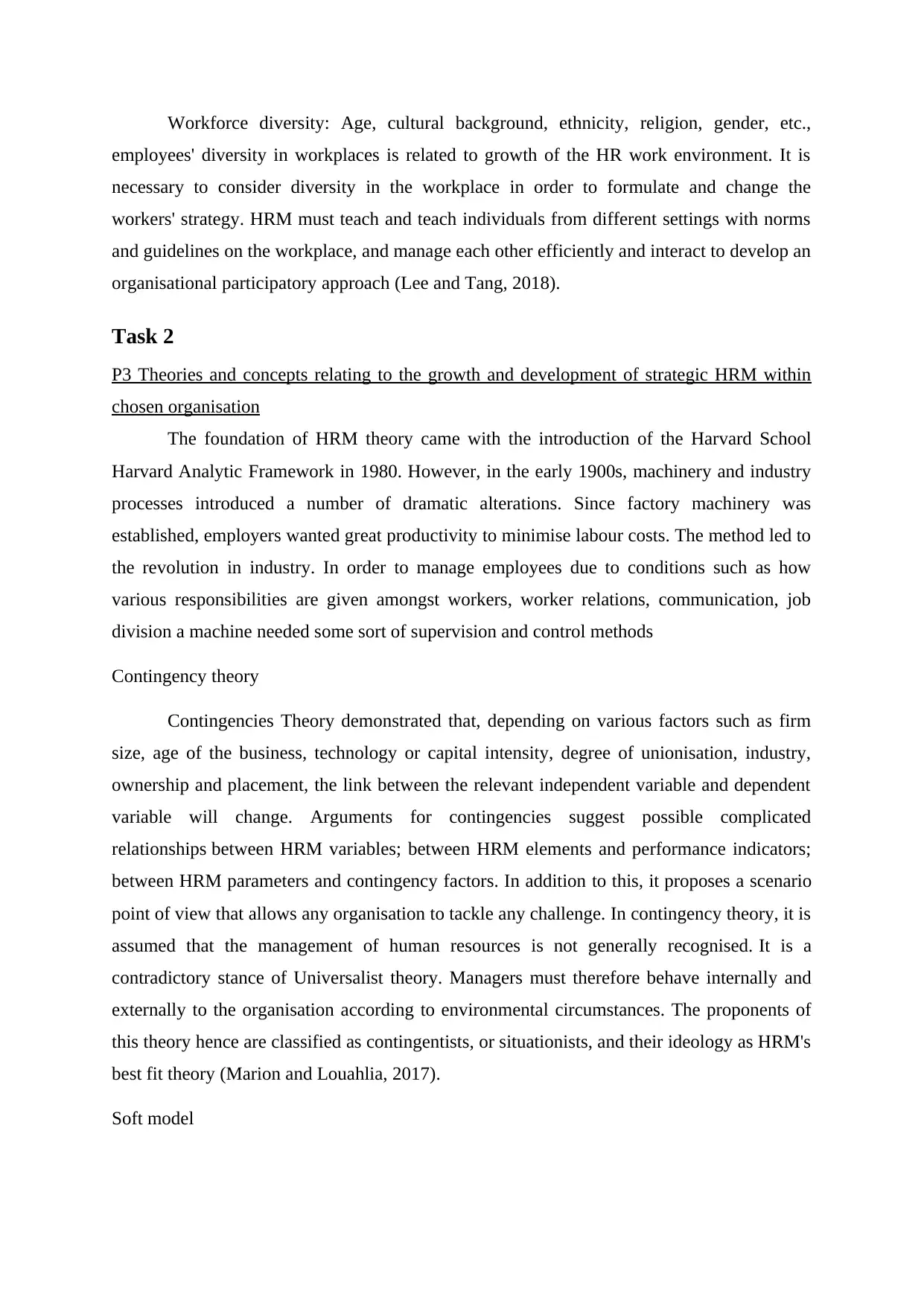
Workforce diversity: Age, cultural background, ethnicity, religion, gender, etc.,
employees' diversity in workplaces is related to growth of the HR work environment. It is
necessary to consider diversity in the workplace in order to formulate and change the
workers' strategy. HRM must teach and teach individuals from different settings with norms
and guidelines on the workplace, and manage each other efficiently and interact to develop an
organisational participatory approach (Lee and Tang, 2018).
Task 2
P3 Theories and concepts relating to the growth and development of strategic HRM within
chosen organisation
The foundation of HRM theory came with the introduction of the Harvard School
Harvard Analytic Framework in 1980. However, in the early 1900s, machinery and industry
processes introduced a number of dramatic alterations. Since factory machinery was
established, employers wanted great productivity to minimise labour costs. The method led to
the revolution in industry. In order to manage employees due to conditions such as how
various responsibilities are given amongst workers, worker relations, communication, job
division a machine needed some sort of supervision and control methods
Contingency theory
Contingencies Theory demonstrated that, depending on various factors such as firm
size, age of the business, technology or capital intensity, degree of unionisation, industry,
ownership and placement, the link between the relevant independent variable and dependent
variable will change. Arguments for contingencies suggest possible complicated
relationships between HRM variables; between HRM elements and performance indicators;
between HRM parameters and contingency factors. In addition to this, it proposes a scenario
point of view that allows any organisation to tackle any challenge. In contingency theory, it is
assumed that the management of human resources is not generally recognised. It is a
contradictory stance of Universalist theory. Managers must therefore behave internally and
externally to the organisation according to environmental circumstances. The proponents of
this theory hence are classified as contingentists, or situationists, and their ideology as HRM's
best fit theory (Marion and Louahlia, 2017).
Soft model
employees' diversity in workplaces is related to growth of the HR work environment. It is
necessary to consider diversity in the workplace in order to formulate and change the
workers' strategy. HRM must teach and teach individuals from different settings with norms
and guidelines on the workplace, and manage each other efficiently and interact to develop an
organisational participatory approach (Lee and Tang, 2018).
Task 2
P3 Theories and concepts relating to the growth and development of strategic HRM within
chosen organisation
The foundation of HRM theory came with the introduction of the Harvard School
Harvard Analytic Framework in 1980. However, in the early 1900s, machinery and industry
processes introduced a number of dramatic alterations. Since factory machinery was
established, employers wanted great productivity to minimise labour costs. The method led to
the revolution in industry. In order to manage employees due to conditions such as how
various responsibilities are given amongst workers, worker relations, communication, job
division a machine needed some sort of supervision and control methods
Contingency theory
Contingencies Theory demonstrated that, depending on various factors such as firm
size, age of the business, technology or capital intensity, degree of unionisation, industry,
ownership and placement, the link between the relevant independent variable and dependent
variable will change. Arguments for contingencies suggest possible complicated
relationships between HRM variables; between HRM elements and performance indicators;
between HRM parameters and contingency factors. In addition to this, it proposes a scenario
point of view that allows any organisation to tackle any challenge. In contingency theory, it is
assumed that the management of human resources is not generally recognised. It is a
contradictory stance of Universalist theory. Managers must therefore behave internally and
externally to the organisation according to environmental circumstances. The proponents of
this theory hence are classified as contingentists, or situationists, and their ideology as HRM's
best fit theory (Marion and Louahlia, 2017).
Soft model
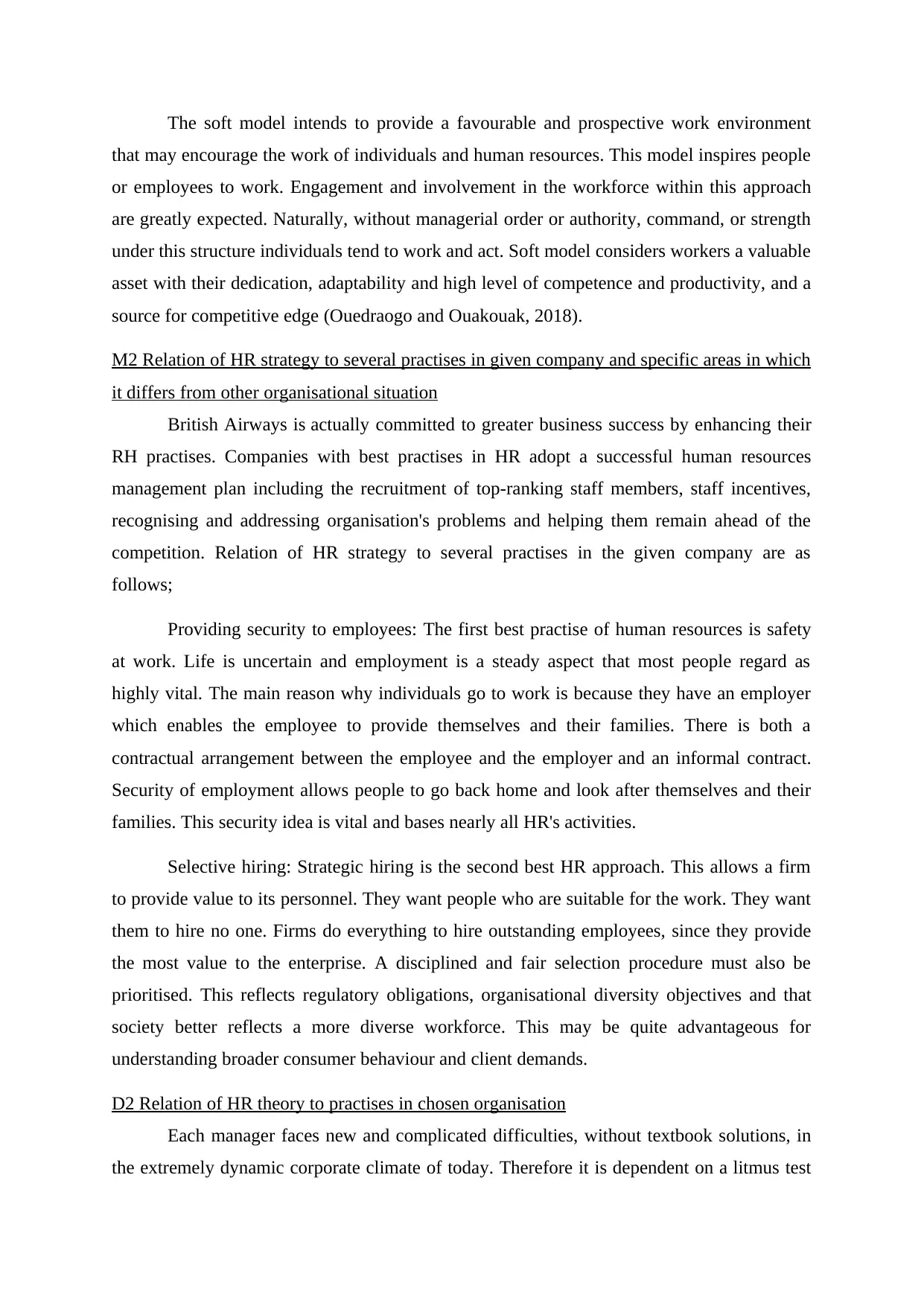
The soft model intends to provide a favourable and prospective work environment
that may encourage the work of individuals and human resources. This model inspires people
or employees to work. Engagement and involvement in the workforce within this approach
are greatly expected. Naturally, without managerial order or authority, command, or strength
under this structure individuals tend to work and act. Soft model considers workers a valuable
asset with their dedication, adaptability and high level of competence and productivity, and a
source for competitive edge (Ouedraogo and Ouakouak, 2018).
M2 Relation of HR strategy to several practises in given company and specific areas in which
it differs from other organisational situation
British Airways is actually committed to greater business success by enhancing their
RH practises. Companies with best practises in HR adopt a successful human resources
management plan including the recruitment of top-ranking staff members, staff incentives,
recognising and addressing organisation's problems and helping them remain ahead of the
competition. Relation of HR strategy to several practises in the given company are as
follows;
Providing security to employees: The first best practise of human resources is safety
at work. Life is uncertain and employment is a steady aspect that most people regard as
highly vital. The main reason why individuals go to work is because they have an employer
which enables the employee to provide themselves and their families. There is both a
contractual arrangement between the employee and the employer and an informal contract.
Security of employment allows people to go back home and look after themselves and their
families. This security idea is vital and bases nearly all HR's activities.
Selective hiring: Strategic hiring is the second best HR approach. This allows a firm
to provide value to its personnel. They want people who are suitable for the work. They want
them to hire no one. Firms do everything to hire outstanding employees, since they provide
the most value to the enterprise. A disciplined and fair selection procedure must also be
prioritised. This reflects regulatory obligations, organisational diversity objectives and that
society better reflects a more diverse workforce. This may be quite advantageous for
understanding broader consumer behaviour and client demands.
D2 Relation of HR theory to practises in chosen organisation
Each manager faces new and complicated difficulties, without textbook solutions, in
the extremely dynamic corporate climate of today. Therefore it is dependent on a litmus test
that may encourage the work of individuals and human resources. This model inspires people
or employees to work. Engagement and involvement in the workforce within this approach
are greatly expected. Naturally, without managerial order or authority, command, or strength
under this structure individuals tend to work and act. Soft model considers workers a valuable
asset with their dedication, adaptability and high level of competence and productivity, and a
source for competitive edge (Ouedraogo and Ouakouak, 2018).
M2 Relation of HR strategy to several practises in given company and specific areas in which
it differs from other organisational situation
British Airways is actually committed to greater business success by enhancing their
RH practises. Companies with best practises in HR adopt a successful human resources
management plan including the recruitment of top-ranking staff members, staff incentives,
recognising and addressing organisation's problems and helping them remain ahead of the
competition. Relation of HR strategy to several practises in the given company are as
follows;
Providing security to employees: The first best practise of human resources is safety
at work. Life is uncertain and employment is a steady aspect that most people regard as
highly vital. The main reason why individuals go to work is because they have an employer
which enables the employee to provide themselves and their families. There is both a
contractual arrangement between the employee and the employer and an informal contract.
Security of employment allows people to go back home and look after themselves and their
families. This security idea is vital and bases nearly all HR's activities.
Selective hiring: Strategic hiring is the second best HR approach. This allows a firm
to provide value to its personnel. They want people who are suitable for the work. They want
them to hire no one. Firms do everything to hire outstanding employees, since they provide
the most value to the enterprise. A disciplined and fair selection procedure must also be
prioritised. This reflects regulatory obligations, organisational diversity objectives and that
society better reflects a more diverse workforce. This may be quite advantageous for
understanding broader consumer behaviour and client demands.
D2 Relation of HR theory to practises in chosen organisation
Each manager faces new and complicated difficulties, without textbook solutions, in
the extremely dynamic corporate climate of today. Therefore it is dependent on a litmus test
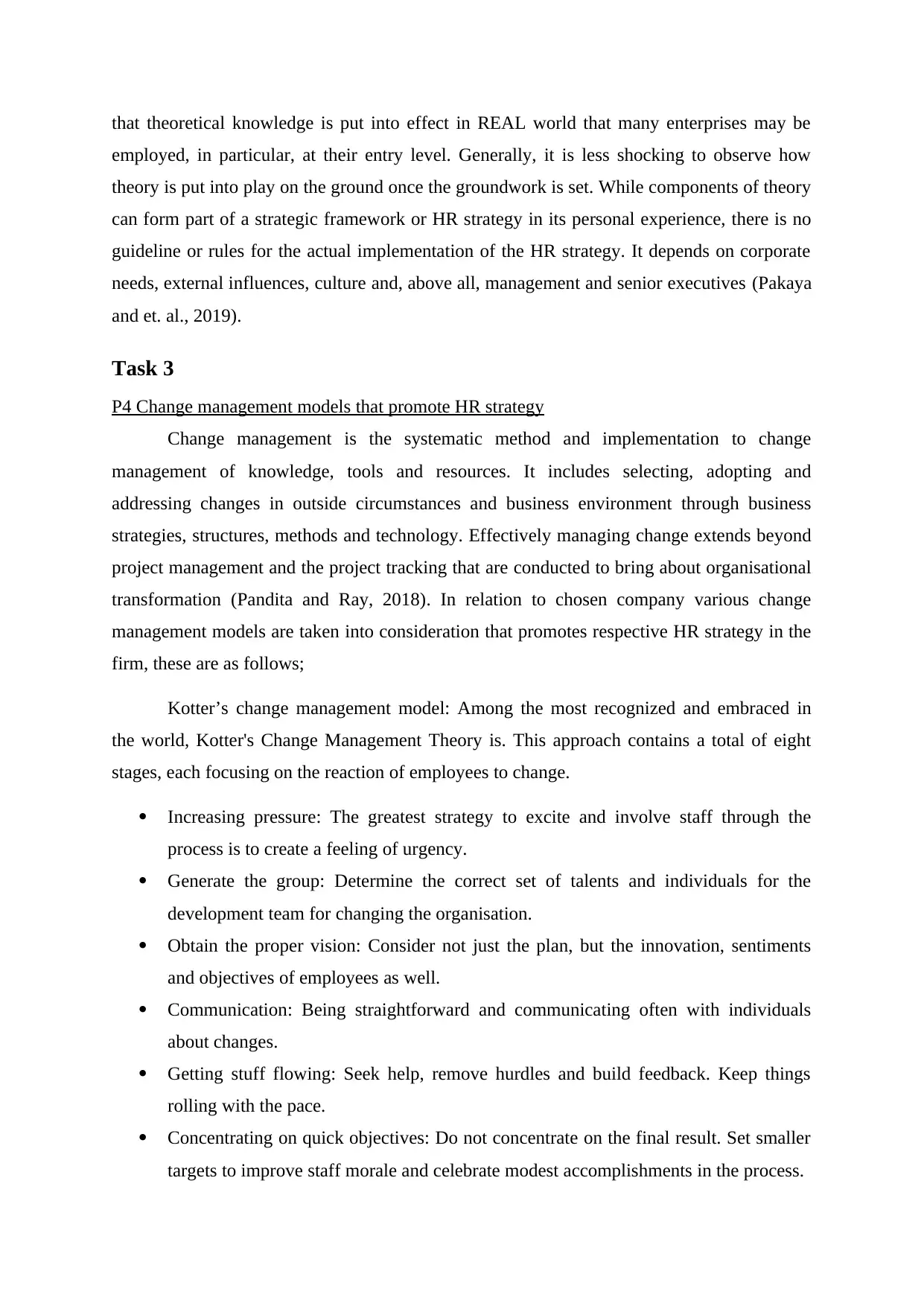
that theoretical knowledge is put into effect in REAL world that many enterprises may be
employed, in particular, at their entry level. Generally, it is less shocking to observe how
theory is put into play on the ground once the groundwork is set. While components of theory
can form part of a strategic framework or HR strategy in its personal experience, there is no
guideline or rules for the actual implementation of the HR strategy. It depends on corporate
needs, external influences, culture and, above all, management and senior executives (Pakaya
and et. al., 2019).
Task 3
P4 Change management models that promote HR strategy
Change management is the systematic method and implementation to change
management of knowledge, tools and resources. It includes selecting, adopting and
addressing changes in outside circumstances and business environment through business
strategies, structures, methods and technology. Effectively managing change extends beyond
project management and the project tracking that are conducted to bring about organisational
transformation (Pandita and Ray, 2018). In relation to chosen company various change
management models are taken into consideration that promotes respective HR strategy in the
firm, these are as follows;
Kotter’s change management model: Among the most recognized and embraced in
the world, Kotter's Change Management Theory is. This approach contains a total of eight
stages, each focusing on the reaction of employees to change.
Increasing pressure: The greatest strategy to excite and involve staff through the
process is to create a feeling of urgency.
Generate the group: Determine the correct set of talents and individuals for the
development team for changing the organisation.
Obtain the proper vision: Consider not just the plan, but the innovation, sentiments
and objectives of employees as well.
Communication: Being straightforward and communicating often with individuals
about changes.
Getting stuff flowing: Seek help, remove hurdles and build feedback. Keep things
rolling with the pace.
Concentrating on quick objectives: Do not concentrate on the final result. Set smaller
targets to improve staff morale and celebrate modest accomplishments in the process.
employed, in particular, at their entry level. Generally, it is less shocking to observe how
theory is put into play on the ground once the groundwork is set. While components of theory
can form part of a strategic framework or HR strategy in its personal experience, there is no
guideline or rules for the actual implementation of the HR strategy. It depends on corporate
needs, external influences, culture and, above all, management and senior executives (Pakaya
and et. al., 2019).
Task 3
P4 Change management models that promote HR strategy
Change management is the systematic method and implementation to change
management of knowledge, tools and resources. It includes selecting, adopting and
addressing changes in outside circumstances and business environment through business
strategies, structures, methods and technology. Effectively managing change extends beyond
project management and the project tracking that are conducted to bring about organisational
transformation (Pandita and Ray, 2018). In relation to chosen company various change
management models are taken into consideration that promotes respective HR strategy in the
firm, these are as follows;
Kotter’s change management model: Among the most recognized and embraced in
the world, Kotter's Change Management Theory is. This approach contains a total of eight
stages, each focusing on the reaction of employees to change.
Increasing pressure: The greatest strategy to excite and involve staff through the
process is to create a feeling of urgency.
Generate the group: Determine the correct set of talents and individuals for the
development team for changing the organisation.
Obtain the proper vision: Consider not just the plan, but the innovation, sentiments
and objectives of employees as well.
Communication: Being straightforward and communicating often with individuals
about changes.
Getting stuff flowing: Seek help, remove hurdles and build feedback. Keep things
rolling with the pace.
Concentrating on quick objectives: Do not concentrate on the final result. Set smaller
targets to improve staff morale and celebrate modest accomplishments in the process.
Secure Best Marks with AI Grader
Need help grading? Try our AI Grader for instant feedback on your assignments.
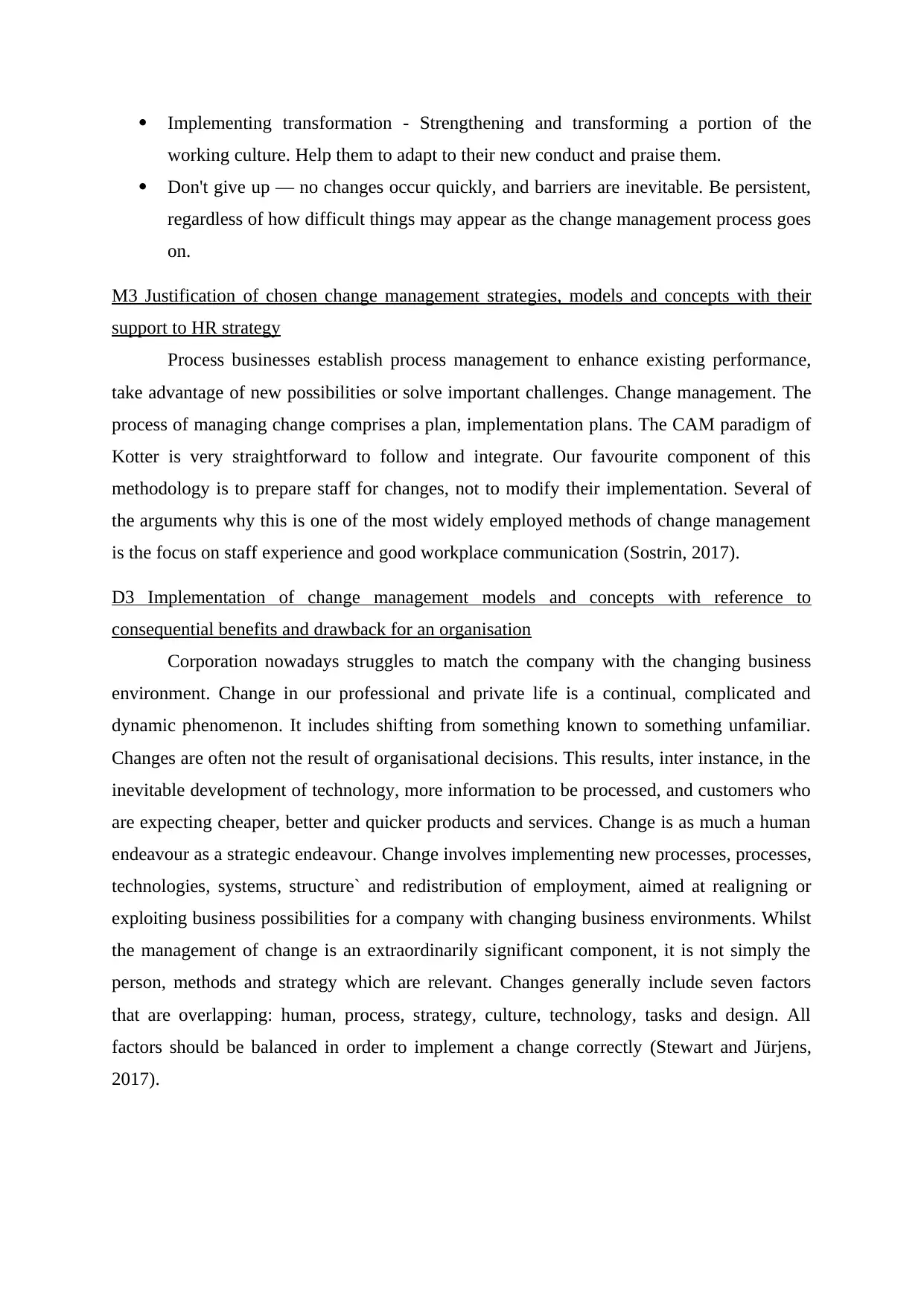
Implementing transformation - Strengthening and transforming a portion of the
working culture. Help them to adapt to their new conduct and praise them.
Don't give up — no changes occur quickly, and barriers are inevitable. Be persistent,
regardless of how difficult things may appear as the change management process goes
on.
M3 Justification of chosen change management strategies, models and concepts with their
support to HR strategy
Process businesses establish process management to enhance existing performance,
take advantage of new possibilities or solve important challenges. Change management. The
process of managing change comprises a plan, implementation plans. The CAM paradigm of
Kotter is very straightforward to follow and integrate. Our favourite component of this
methodology is to prepare staff for changes, not to modify their implementation. Several of
the arguments why this is one of the most widely employed methods of change management
is the focus on staff experience and good workplace communication (Sostrin, 2017).
D3 Implementation of change management models and concepts with reference to
consequential benefits and drawback for an organisation
Corporation nowadays struggles to match the company with the changing business
environment. Change in our professional and private life is a continual, complicated and
dynamic phenomenon. It includes shifting from something known to something unfamiliar.
Changes are often not the result of organisational decisions. This results, inter instance, in the
inevitable development of technology, more information to be processed, and customers who
are expecting cheaper, better and quicker products and services. Change is as much a human
endeavour as a strategic endeavour. Change involves implementing new processes, processes,
technologies, systems, structure` and redistribution of employment, aimed at realigning or
exploiting business possibilities for a company with changing business environments. Whilst
the management of change is an extraordinarily significant component, it is not simply the
person, methods and strategy which are relevant. Changes generally include seven factors
that are overlapping: human, process, strategy, culture, technology, tasks and design. All
factors should be balanced in order to implement a change correctly (Stewart and Jürjens,
2017).
working culture. Help them to adapt to their new conduct and praise them.
Don't give up — no changes occur quickly, and barriers are inevitable. Be persistent,
regardless of how difficult things may appear as the change management process goes
on.
M3 Justification of chosen change management strategies, models and concepts with their
support to HR strategy
Process businesses establish process management to enhance existing performance,
take advantage of new possibilities or solve important challenges. Change management. The
process of managing change comprises a plan, implementation plans. The CAM paradigm of
Kotter is very straightforward to follow and integrate. Our favourite component of this
methodology is to prepare staff for changes, not to modify their implementation. Several of
the arguments why this is one of the most widely employed methods of change management
is the focus on staff experience and good workplace communication (Sostrin, 2017).
D3 Implementation of change management models and concepts with reference to
consequential benefits and drawback for an organisation
Corporation nowadays struggles to match the company with the changing business
environment. Change in our professional and private life is a continual, complicated and
dynamic phenomenon. It includes shifting from something known to something unfamiliar.
Changes are often not the result of organisational decisions. This results, inter instance, in the
inevitable development of technology, more information to be processed, and customers who
are expecting cheaper, better and quicker products and services. Change is as much a human
endeavour as a strategic endeavour. Change involves implementing new processes, processes,
technologies, systems, structure` and redistribution of employment, aimed at realigning or
exploiting business possibilities for a company with changing business environments. Whilst
the management of change is an extraordinarily significant component, it is not simply the
person, methods and strategy which are relevant. Changes generally include seven factors
that are overlapping: human, process, strategy, culture, technology, tasks and design. All
factors should be balanced in order to implement a change correctly (Stewart and Jürjens,
2017).
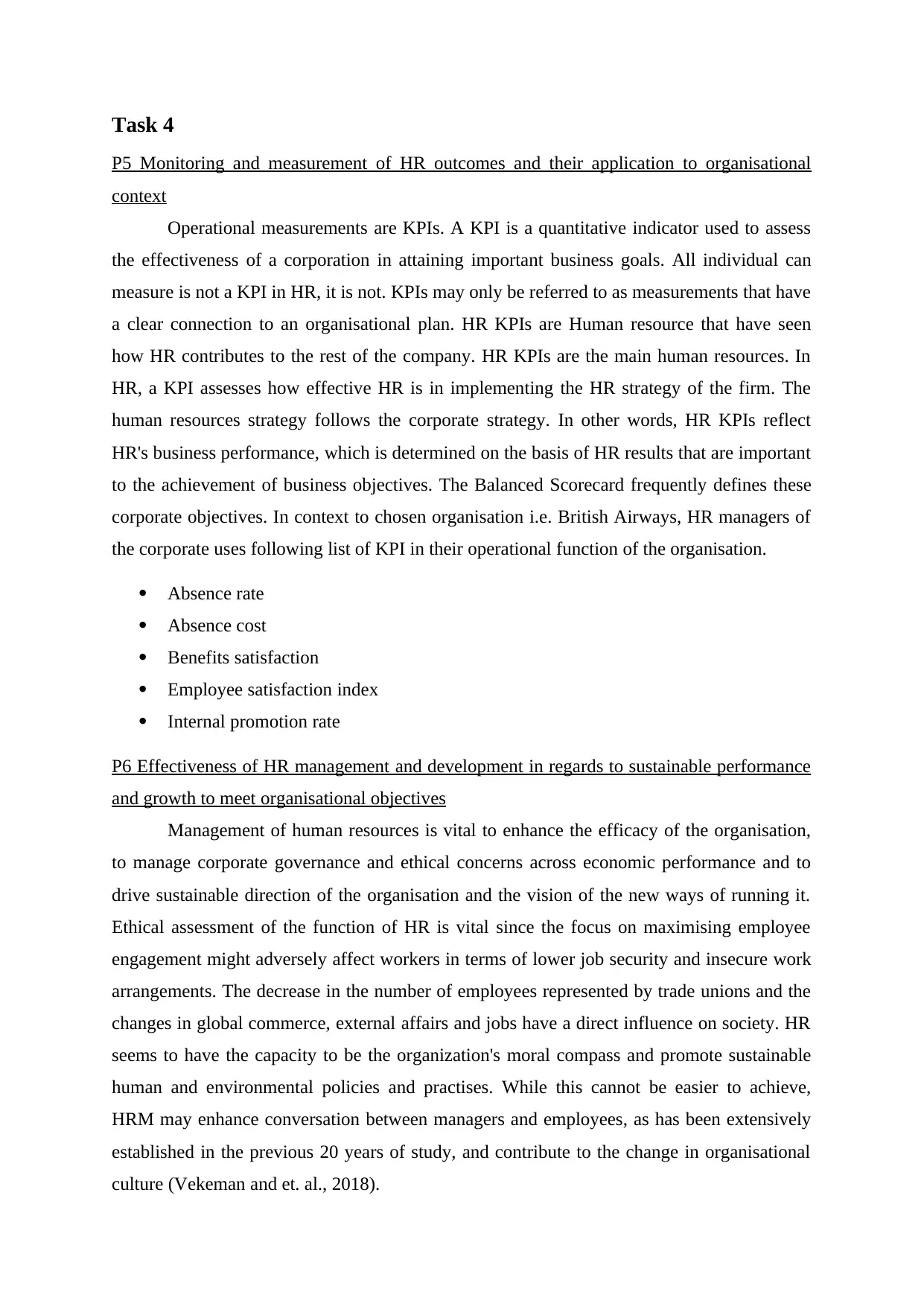
Task 4
P5 Monitoring and measurement of HR outcomes and their application to organisational
context
Operational measurements are KPIs. A KPI is a quantitative indicator used to assess
the effectiveness of a corporation in attaining important business goals. All individual can
measure is not a KPI in HR, it is not. KPIs may only be referred to as measurements that have
a clear connection to an organisational plan. HR KPIs are Human resource that have seen
how HR contributes to the rest of the company. HR KPIs are the main human resources. In
HR, a KPI assesses how effective HR is in implementing the HR strategy of the firm. The
human resources strategy follows the corporate strategy. In other words, HR KPIs reflect
HR's business performance, which is determined on the basis of HR results that are important
to the achievement of business objectives. The Balanced Scorecard frequently defines these
corporate objectives. In context to chosen organisation i.e. British Airways, HR managers of
the corporate uses following list of KPI in their operational function of the organisation.
Absence rate
Absence cost
Benefits satisfaction
Employee satisfaction index
Internal promotion rate
P6 Effectiveness of HR management and development in regards to sustainable performance
and growth to meet organisational objectives
Management of human resources is vital to enhance the efficacy of the organisation,
to manage corporate governance and ethical concerns across economic performance and to
drive sustainable direction of the organisation and the vision of the new ways of running it.
Ethical assessment of the function of HR is vital since the focus on maximising employee
engagement might adversely affect workers in terms of lower job security and insecure work
arrangements. The decrease in the number of employees represented by trade unions and the
changes in global commerce, external affairs and jobs have a direct influence on society. HR
seems to have the capacity to be the organization's moral compass and promote sustainable
human and environmental policies and practises. While this cannot be easier to achieve,
HRM may enhance conversation between managers and employees, as has been extensively
established in the previous 20 years of study, and contribute to the change in organisational
culture (Vekeman and et. al., 2018).
P5 Monitoring and measurement of HR outcomes and their application to organisational
context
Operational measurements are KPIs. A KPI is a quantitative indicator used to assess
the effectiveness of a corporation in attaining important business goals. All individual can
measure is not a KPI in HR, it is not. KPIs may only be referred to as measurements that have
a clear connection to an organisational plan. HR KPIs are Human resource that have seen
how HR contributes to the rest of the company. HR KPIs are the main human resources. In
HR, a KPI assesses how effective HR is in implementing the HR strategy of the firm. The
human resources strategy follows the corporate strategy. In other words, HR KPIs reflect
HR's business performance, which is determined on the basis of HR results that are important
to the achievement of business objectives. The Balanced Scorecard frequently defines these
corporate objectives. In context to chosen organisation i.e. British Airways, HR managers of
the corporate uses following list of KPI in their operational function of the organisation.
Absence rate
Absence cost
Benefits satisfaction
Employee satisfaction index
Internal promotion rate
P6 Effectiveness of HR management and development in regards to sustainable performance
and growth to meet organisational objectives
Management of human resources is vital to enhance the efficacy of the organisation,
to manage corporate governance and ethical concerns across economic performance and to
drive sustainable direction of the organisation and the vision of the new ways of running it.
Ethical assessment of the function of HR is vital since the focus on maximising employee
engagement might adversely affect workers in terms of lower job security and insecure work
arrangements. The decrease in the number of employees represented by trade unions and the
changes in global commerce, external affairs and jobs have a direct influence on society. HR
seems to have the capacity to be the organization's moral compass and promote sustainable
human and environmental policies and practises. While this cannot be easier to achieve,
HRM may enhance conversation between managers and employees, as has been extensively
established in the previous 20 years of study, and contribute to the change in organisational
culture (Vekeman and et. al., 2018).
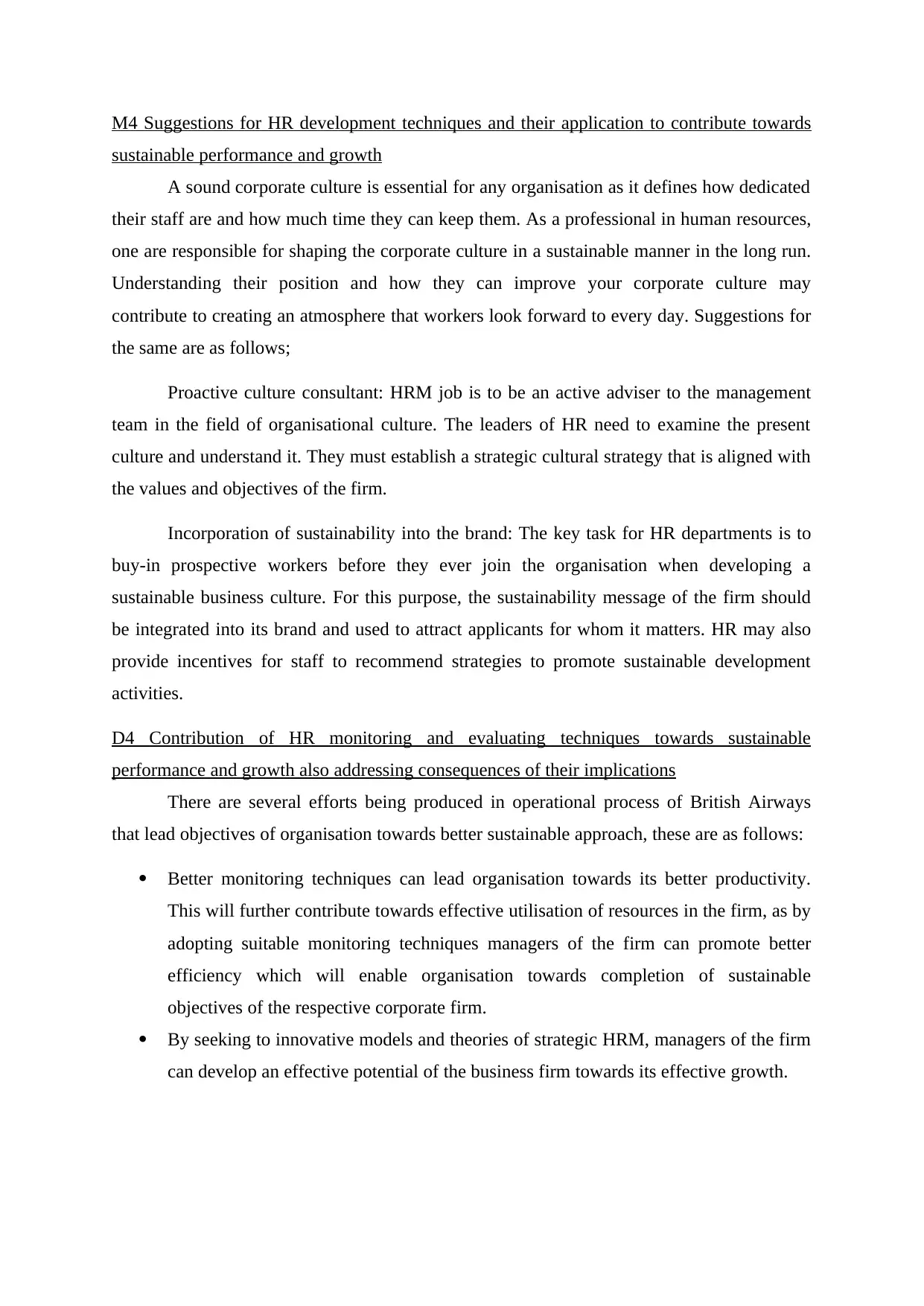
M4 Suggestions for HR development techniques and their application to contribute towards
sustainable performance and growth
A sound corporate culture is essential for any organisation as it defines how dedicated
their staff are and how much time they can keep them. As a professional in human resources,
one are responsible for shaping the corporate culture in a sustainable manner in the long run.
Understanding their position and how they can improve your corporate culture may
contribute to creating an atmosphere that workers look forward to every day. Suggestions for
the same are as follows;
Proactive culture consultant: HRM job is to be an active adviser to the management
team in the field of organisational culture. The leaders of HR need to examine the present
culture and understand it. They must establish a strategic cultural strategy that is aligned with
the values and objectives of the firm.
Incorporation of sustainability into the brand: The key task for HR departments is to
buy-in prospective workers before they ever join the organisation when developing a
sustainable business culture. For this purpose, the sustainability message of the firm should
be integrated into its brand and used to attract applicants for whom it matters. HR may also
provide incentives for staff to recommend strategies to promote sustainable development
activities.
D4 Contribution of HR monitoring and evaluating techniques towards sustainable
performance and growth also addressing consequences of their implications
There are several efforts being produced in operational process of British Airways
that lead objectives of organisation towards better sustainable approach, these are as follows:
Better monitoring techniques can lead organisation towards its better productivity.
This will further contribute towards effective utilisation of resources in the firm, as by
adopting suitable monitoring techniques managers of the firm can promote better
efficiency which will enable organisation towards completion of sustainable
objectives of the respective corporate firm.
By seeking to innovative models and theories of strategic HRM, managers of the firm
can develop an effective potential of the business firm towards its effective growth.
sustainable performance and growth
A sound corporate culture is essential for any organisation as it defines how dedicated
their staff are and how much time they can keep them. As a professional in human resources,
one are responsible for shaping the corporate culture in a sustainable manner in the long run.
Understanding their position and how they can improve your corporate culture may
contribute to creating an atmosphere that workers look forward to every day. Suggestions for
the same are as follows;
Proactive culture consultant: HRM job is to be an active adviser to the management
team in the field of organisational culture. The leaders of HR need to examine the present
culture and understand it. They must establish a strategic cultural strategy that is aligned with
the values and objectives of the firm.
Incorporation of sustainability into the brand: The key task for HR departments is to
buy-in prospective workers before they ever join the organisation when developing a
sustainable business culture. For this purpose, the sustainability message of the firm should
be integrated into its brand and used to attract applicants for whom it matters. HR may also
provide incentives for staff to recommend strategies to promote sustainable development
activities.
D4 Contribution of HR monitoring and evaluating techniques towards sustainable
performance and growth also addressing consequences of their implications
There are several efforts being produced in operational process of British Airways
that lead objectives of organisation towards better sustainable approach, these are as follows:
Better monitoring techniques can lead organisation towards its better productivity.
This will further contribute towards effective utilisation of resources in the firm, as by
adopting suitable monitoring techniques managers of the firm can promote better
efficiency which will enable organisation towards completion of sustainable
objectives of the respective corporate firm.
By seeking to innovative models and theories of strategic HRM, managers of the firm
can develop an effective potential of the business firm towards its effective growth.
Paraphrase This Document
Need a fresh take? Get an instant paraphrase of this document with our AI Paraphraser
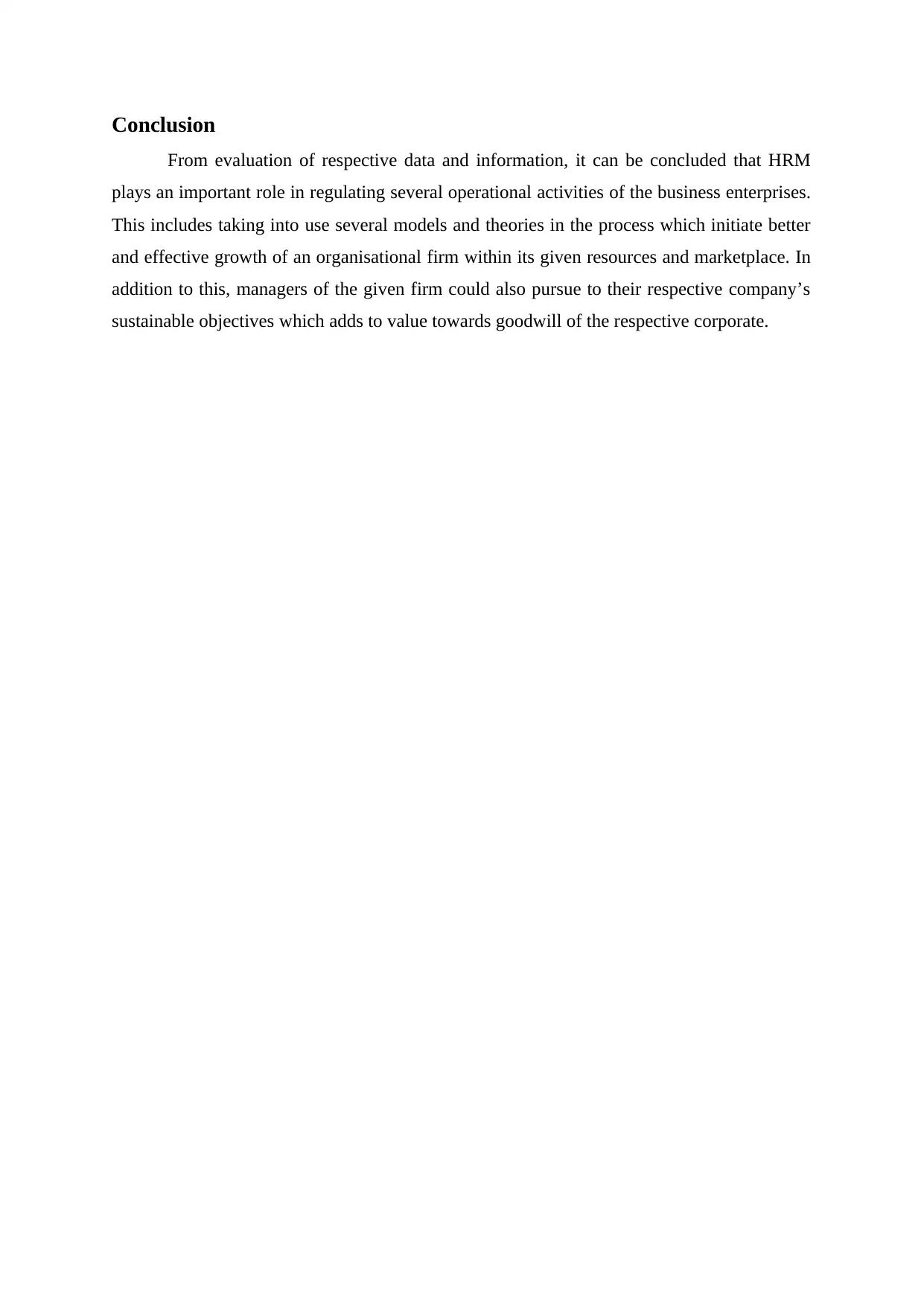
Conclusion
From evaluation of respective data and information, it can be concluded that HRM
plays an important role in regulating several operational activities of the business enterprises.
This includes taking into use several models and theories in the process which initiate better
and effective growth of an organisational firm within its given resources and marketplace. In
addition to this, managers of the given firm could also pursue to their respective company’s
sustainable objectives which adds to value towards goodwill of the respective corporate.
From evaluation of respective data and information, it can be concluded that HRM
plays an important role in regulating several operational activities of the business enterprises.
This includes taking into use several models and theories in the process which initiate better
and effective growth of an organisational firm within its given resources and marketplace. In
addition to this, managers of the given firm could also pursue to their respective company’s
sustainable objectives which adds to value towards goodwill of the respective corporate.
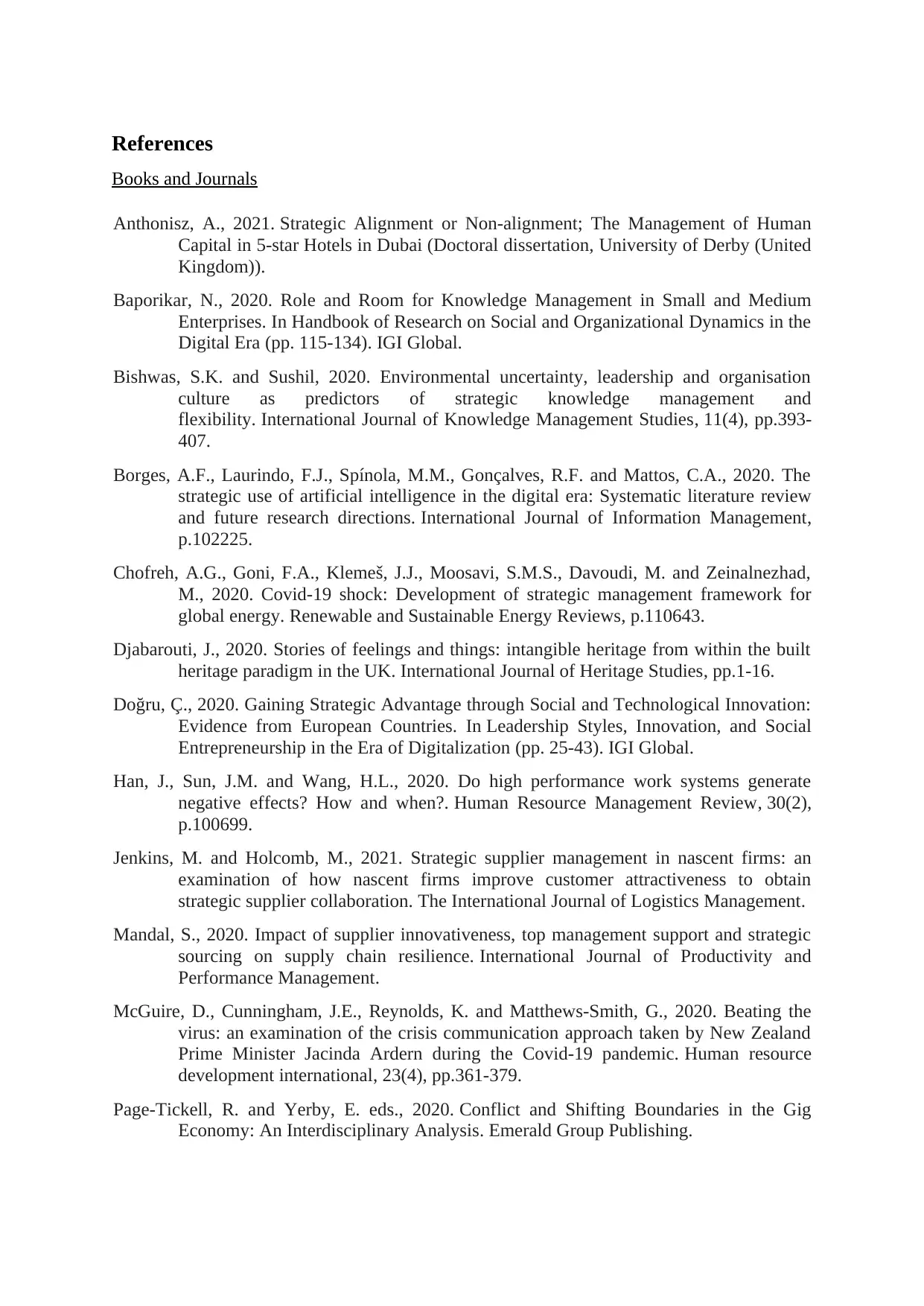
References
Books and Journals
Anthonisz, A., 2021. Strategic Alignment or Non-alignment; The Management of Human
Capital in 5-star Hotels in Dubai (Doctoral dissertation, University of Derby (United
Kingdom)).
Baporikar, N., 2020. Role and Room for Knowledge Management in Small and Medium
Enterprises. In Handbook of Research on Social and Organizational Dynamics in the
Digital Era (pp. 115-134). IGI Global.
Bishwas, S.K. and Sushil, 2020. Environmental uncertainty, leadership and organisation
culture as predictors of strategic knowledge management and
flexibility. International Journal of Knowledge Management Studies, 11(4), pp.393-
407.
Borges, A.F., Laurindo, F.J., Spínola, M.M., Gonçalves, R.F. and Mattos, C.A., 2020. The
strategic use of artificial intelligence in the digital era: Systematic literature review
and future research directions. International Journal of Information Management,
p.102225.
Chofreh, A.G., Goni, F.A., Klemeš, J.J., Moosavi, S.M.S., Davoudi, M. and Zeinalnezhad,
M., 2020. Covid-19 shock: Development of strategic management framework for
global energy. Renewable and Sustainable Energy Reviews, p.110643.
Djabarouti, J., 2020. Stories of feelings and things: intangible heritage from within the built
heritage paradigm in the UK. International Journal of Heritage Studies, pp.1-16.
Doğru, Ç., 2020. Gaining Strategic Advantage through Social and Technological Innovation:
Evidence from European Countries. In Leadership Styles, Innovation, and Social
Entrepreneurship in the Era of Digitalization (pp. 25-43). IGI Global.
Han, J., Sun, J.M. and Wang, H.L., 2020. Do high performance work systems generate
negative effects? How and when?. Human Resource Management Review, 30(2),
p.100699.
Jenkins, M. and Holcomb, M., 2021. Strategic supplier management in nascent firms: an
examination of how nascent firms improve customer attractiveness to obtain
strategic supplier collaboration. The International Journal of Logistics Management.
Mandal, S., 2020. Impact of supplier innovativeness, top management support and strategic
sourcing on supply chain resilience. International Journal of Productivity and
Performance Management.
McGuire, D., Cunningham, J.E., Reynolds, K. and Matthews-Smith, G., 2020. Beating the
virus: an examination of the crisis communication approach taken by New Zealand
Prime Minister Jacinda Ardern during the Covid-19 pandemic. Human resource
development international, 23(4), pp.361-379.
Page-Tickell, R. and Yerby, E. eds., 2020. Conflict and Shifting Boundaries in the Gig
Economy: An Interdisciplinary Analysis. Emerald Group Publishing.
Books and Journals
Anthonisz, A., 2021. Strategic Alignment or Non-alignment; The Management of Human
Capital in 5-star Hotels in Dubai (Doctoral dissertation, University of Derby (United
Kingdom)).
Baporikar, N., 2020. Role and Room for Knowledge Management in Small and Medium
Enterprises. In Handbook of Research on Social and Organizational Dynamics in the
Digital Era (pp. 115-134). IGI Global.
Bishwas, S.K. and Sushil, 2020. Environmental uncertainty, leadership and organisation
culture as predictors of strategic knowledge management and
flexibility. International Journal of Knowledge Management Studies, 11(4), pp.393-
407.
Borges, A.F., Laurindo, F.J., Spínola, M.M., Gonçalves, R.F. and Mattos, C.A., 2020. The
strategic use of artificial intelligence in the digital era: Systematic literature review
and future research directions. International Journal of Information Management,
p.102225.
Chofreh, A.G., Goni, F.A., Klemeš, J.J., Moosavi, S.M.S., Davoudi, M. and Zeinalnezhad,
M., 2020. Covid-19 shock: Development of strategic management framework for
global energy. Renewable and Sustainable Energy Reviews, p.110643.
Djabarouti, J., 2020. Stories of feelings and things: intangible heritage from within the built
heritage paradigm in the UK. International Journal of Heritage Studies, pp.1-16.
Doğru, Ç., 2020. Gaining Strategic Advantage through Social and Technological Innovation:
Evidence from European Countries. In Leadership Styles, Innovation, and Social
Entrepreneurship in the Era of Digitalization (pp. 25-43). IGI Global.
Han, J., Sun, J.M. and Wang, H.L., 2020. Do high performance work systems generate
negative effects? How and when?. Human Resource Management Review, 30(2),
p.100699.
Jenkins, M. and Holcomb, M., 2021. Strategic supplier management in nascent firms: an
examination of how nascent firms improve customer attractiveness to obtain
strategic supplier collaboration. The International Journal of Logistics Management.
Mandal, S., 2020. Impact of supplier innovativeness, top management support and strategic
sourcing on supply chain resilience. International Journal of Productivity and
Performance Management.
McGuire, D., Cunningham, J.E., Reynolds, K. and Matthews-Smith, G., 2020. Beating the
virus: an examination of the crisis communication approach taken by New Zealand
Prime Minister Jacinda Ardern during the Covid-19 pandemic. Human resource
development international, 23(4), pp.361-379.
Page-Tickell, R. and Yerby, E. eds., 2020. Conflict and Shifting Boundaries in the Gig
Economy: An Interdisciplinary Analysis. Emerald Group Publishing.
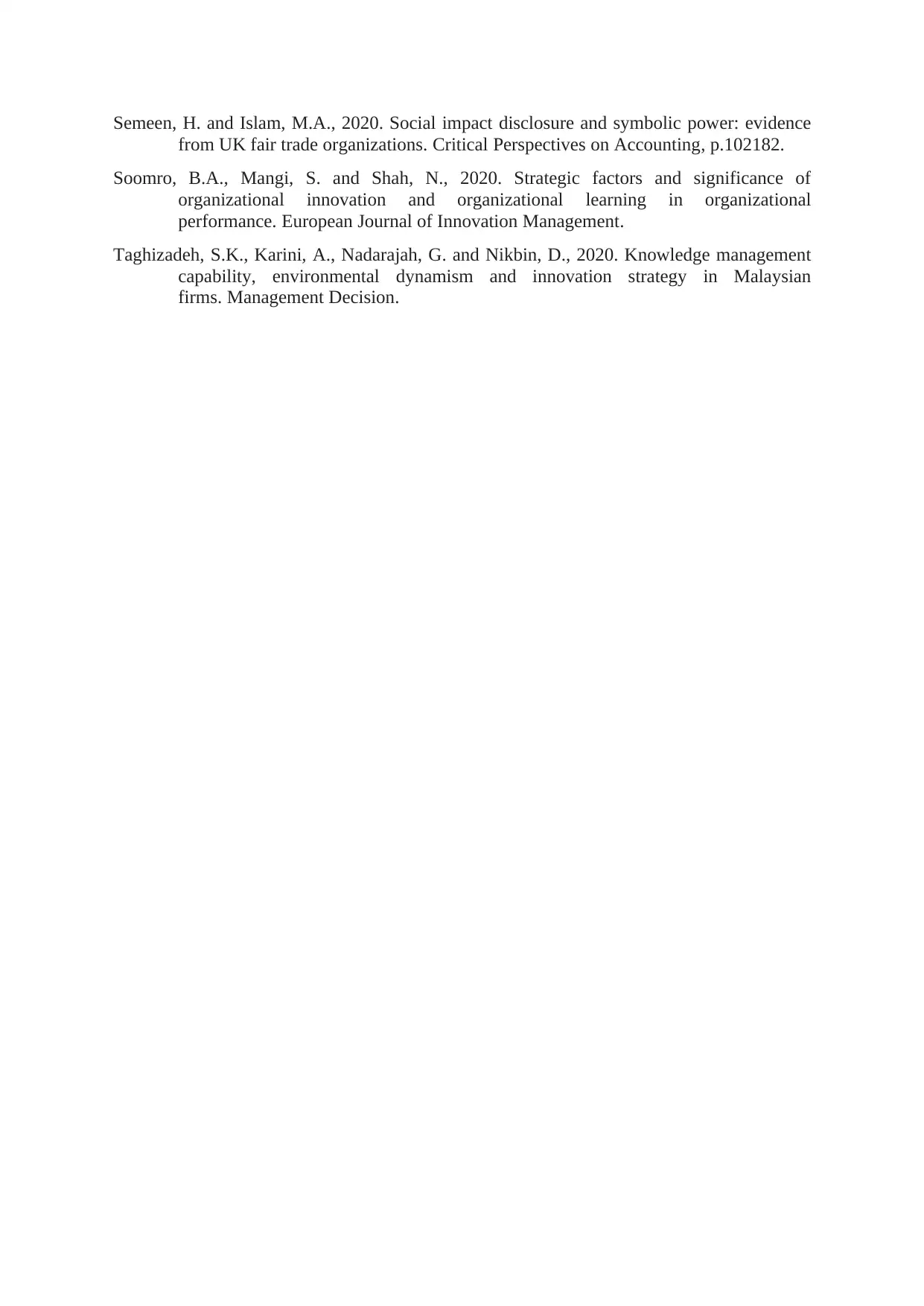
Semeen, H. and Islam, M.A., 2020. Social impact disclosure and symbolic power: evidence
from UK fair trade organizations. Critical Perspectives on Accounting, p.102182.
Soomro, B.A., Mangi, S. and Shah, N., 2020. Strategic factors and significance of
organizational innovation and organizational learning in organizational
performance. European Journal of Innovation Management.
Taghizadeh, S.K., Karini, A., Nadarajah, G. and Nikbin, D., 2020. Knowledge management
capability, environmental dynamism and innovation strategy in Malaysian
firms. Management Decision.
from UK fair trade organizations. Critical Perspectives on Accounting, p.102182.
Soomro, B.A., Mangi, S. and Shah, N., 2020. Strategic factors and significance of
organizational innovation and organizational learning in organizational
performance. European Journal of Innovation Management.
Taghizadeh, S.K., Karini, A., Nadarajah, G. and Nikbin, D., 2020. Knowledge management
capability, environmental dynamism and innovation strategy in Malaysian
firms. Management Decision.
1 out of 16
Related Documents
Your All-in-One AI-Powered Toolkit for Academic Success.
+13062052269
info@desklib.com
Available 24*7 on WhatsApp / Email
![[object Object]](/_next/static/media/star-bottom.7253800d.svg)
Unlock your academic potential
© 2024 | Zucol Services PVT LTD | All rights reserved.




